Drumlins: pretty little hills
Windows Through Time
Robert Titus
Sept. 10, 2010 in Columbia Greene Media
I would like to introduce you to a new geological topic today, one which is very important throughout the Hudson Valley. That is the drumlin. Drumlin is a Gaelic work for hill, but these are very special hills with very special origins. Hills come in all shapes and sizes; they are found everywhere. What makes a drumlin different is its particular shape and the particular type of place where it is found.
A drumlin is said to have the shape of an upside down spoon bowl, so we can start by having you take out a typical spoon, turning it over, and looking at it from what would normally be below. You will see a very nice symmetrical oval shape to the spoon bowl. It is wider at the handle end and tapers to a narrow front. Now turn your spoon sideways, but still upside down and look at it from this angle. The handle end is steep but the angle, again, tapers towards the front.

A teaspoon bowl, shaped like an upside down drumlin.
These are exactly the forms we see in a drumlin; you just have to scale it all up in size . . . a lot. Drumlins can be a mile long, up to 150 feet in height and they can be more than 1,500 feet wide. Most are a good bit smaller, but they are large. They are like potato chips; you can’t just have one. It is very unusual to just see one of them; typically they occur in drumlin fields where they can number in the scores and sometimes many more. And those drumlins fields are, as I said, only found in particular landscapes: areas that had been glaciated.

A drumlin field, arrows show direction of glacial movement.
Drumlins display compass directions and those directions speak to us of their origins. Typically drumlins are parallel to each other, and parallel to the long ago flow of the glaciers that formed them. In the Hudson Valley they are commonly oriented north to south.
But how, exactly, did the glaciers form them? Late at night, in geology bars, that issue has been debated for decades. It is not easy to describe the origins of drumlins without using the word sculpting. It would seem that glaciers pass across large masses of coarse glacial sediment and sculpt those materials into the forms we see, but more explanation is needed. The big problem is that nobody has ever been to the bottom of a glacier that was sculpting a drumlin so we can’t go and observe the process.
It may be that drumlins formed late in the Ice Age, when the climate had been warming up. Water would melt out of the glacier and soak into the sediments below. That would make them soft and very pliable and speed up the sculpting process. But, again, nobody has been there to see this happen.
But, for our purposes, something that is very important is that drumlins are scenic and make for very nice landscape. Recognizing them is important to appreciating our Hudson Valley landscapes. You need to see one.
We will, in the future, visit a lot of drumlins and a number of drumlin fields, but today I would like to just recommend a visit to just one, a good one. That would be in the Hudson Valley Hamlet of Viewmonte, along the northern edge of Clermont. Take Rte. 9G south from the Rip Van Winkle Bridge about five miles. Watch on the left (east) for Cemetery Road. Take that left and, less than a mile down the road, you will see a cemetery on the right. If you are not careful you will pass by its inconspicuous entrance so watch it. Drive up that narrow driveway. You have not only entered a cemetery, but you have entered onto a drumlin and a very good one. You are driving up the north end of the hill and this is the steep side. When you reach the top, you will appreciate just how symmetrical a drumlin can be, Steep, but very smooth slopes, form the two, east and west, sides of the drumlin. At the back of the cemetery the driveway forms a turnaround and there you have reached the tapered downstream end of the hill.

The top of the cemetery drumlin at Viewmonte
This is a very good drumlin; it has all the morphology that you would expect to see. Being a graveyard, the landscape has been kept open; there are few trees or shrubs to block the view. So this is a very good “introductory” drumlin. We will, in the future, see many more and we will learn about drumlin fields and see what they have to tell us about the ice age history of our region. They, if fact, have much to say.
Contact the author at titusr@hartwick.edu or visit his facebook page ’The Catskill Geologist.”





